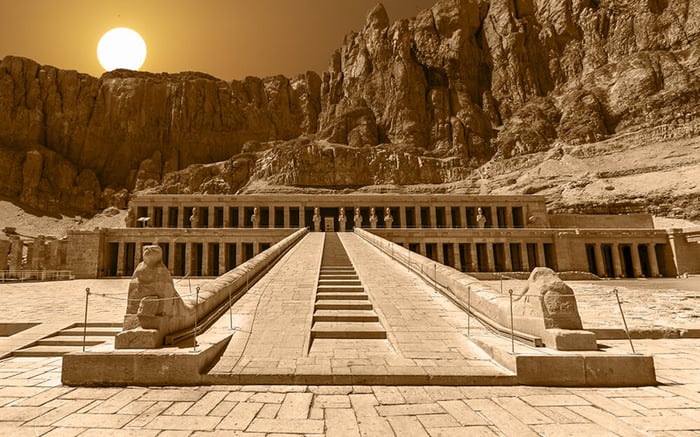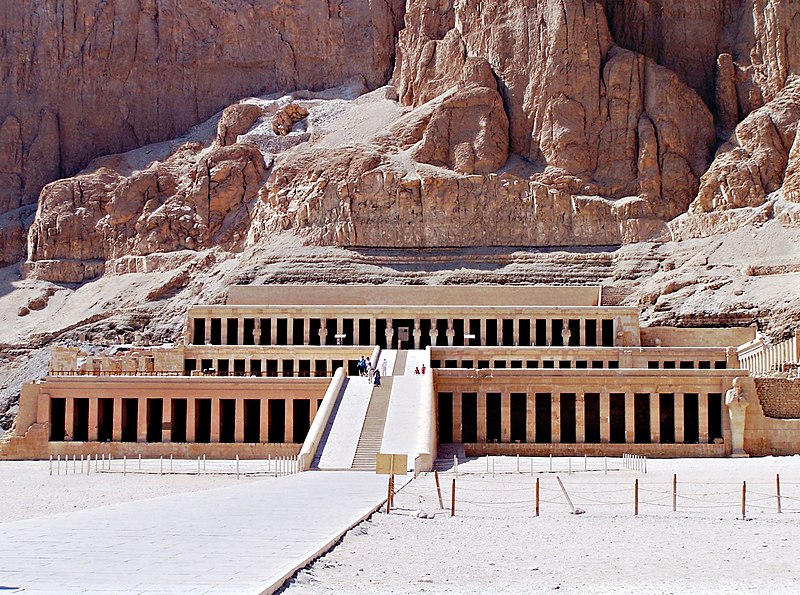Introduction
The Hatshepsut Mortuary Temple, known as Djeser-Djeseru (“Holy of Holies”), is one of the most stunning and well-preserved examples of ancient Egyptian architecture. Built under the reign of Queen Hatshepsut, one of Egypt’s most prominent female pharaohs, this temple is situated on the West Bank of the Nile in Luxor, beneath the towering cliffs of Deir el-Bahari. Constructed during the 18th Dynasty (c. 1479-1458 BCE), the temple served both as a mortuary complex for Hatshepsut and a place of worship for the god Amun-Ra. The temple’s design by her royal architect Senenmut showcases not only the grandeur of Hatshepsut’s reign but also the ingenuity of ancient Egyptian builders.
Architectural Marvel and Integration with Nature
One of the most extraordinary features of the Hatshepsut Mortuary Temple is its seamless integration with the natural landscape. The temple’s three grand terraces rise in harmony with the cliffs behind them, creating an architectural masterpiece that blends man-made elegance with the surrounding desert environment. This design choice reflects the ancient Egyptians’ reverence for the natural world and their belief in the divine connection between the earth and the heavens.

The symmetry and order of the terraces embody the Egyptian concept of ma’at (balance and harmony), while the vast open spaces between the columns and courtyards allow for a tranquil and awe-inspiring atmosphere. The natural light from the sun further illuminates the temple, adding to its ethereal beauty. This level of craftsmanship not only demonstrates the aesthetic mastery of Egyptian builders but also their deep understanding of architecture’s role in creating sacred spaces.
The Sphinx-Lined Pathway and Symbolism 🐆
The sphinx-lined pathway leading to the temple is equally impressive, reflecting the grandeur and power of Hatshepsut’s reign. These statues, depicting lion-bodied creatures with human heads, serve as symbolic guardians of the temple and representations of royal authority and divine protection. As visitors approach the temple, the sphinxes create a powerful visual narrative, reinforcing Hatshepsut’s legitimacy as a pharaoh and the divine nature of her rule.
Once inside the temple complex, visitors are greeted by intricate carvings and reliefs that tell the story of Hatshepsut’s reign. Scenes of her divine birth, coronation, and her successful trading expedition to the Land of Punt are masterfully depicted on the walls, showcasing her achievements and divine favor. These carvings not only celebrate her accomplishments but also emphasize the importance of the gods in legitimizing her rule. The detailed artistry is a testament to the skills of New Kingdom artisans and their ability to immortalize their rulers through stone.
Spiritual and Political Significance ✨
The Hatshepsut Mortuary Temple is not just an architectural wonder; it also held immense spiritual and political significance. Dedicated to the god Amun-Ra, the temple functioned as a sacred space where rituals and offerings were made to ensure Hatshepsut’s eternal life in the afterworld. This spiritual devotion is woven into the very fabric of the temple, with altars and statues dedicated to the gods and the pharaoh herself.

By commissioning such an extraordinary structure, Hatshepsut aimed to secure her place in history and the afterlife. As one of Egypt’s few female pharaohs, her reign was groundbreaking, and she used architecture to legitimize her rule and demonstrate her divine right to lead. The temple’s size, location, and beauty all reflected her ambition to be remembered as one of Egypt’s greatest rulers.
Intricate Carvings and Historical Depictions 📜
Among the temple’s many artistic treasures are the intricate carvings that document important events during Hatshepsut’s reign. The most famous of these is the depiction of her expedition to Punt, a prosperous land thought to be located along the Red Sea or the Horn of Africa. This trading mission brought back valuable goods such as incense, ebony, ivory, and gold, solidifying Egypt’s wealth and power during Hatshepsut’s reign. The carvings of Punt are remarkable for their detail and provide rare insight into one of the few documented Egyptian expeditions to foreign lands.
In addition to the scenes of Punt, the temple’s walls are adorned with representations of Hatshepsut’s relationship with the gods, including Amun-Ra, whom she claimed as her divine father. These depictions were carefully crafted to reinforce her divine authority and to ensure that her legacy as a god-king would endure.
Legacy and Preservation 🌟
Today, the Hatshepsut Mortuary Temple remains one of Egypt’s most revered ancient monuments, drawing countless visitors from around the world. Despite facing centuries of natural erosion, deliberate defacement by her successor Thutmose III, and other environmental challenges, the temple has undergone extensive restoration. The preservation efforts have allowed modern visitors to experience the temple much as it appeared in Hatshepsut’s time, marveling at its grandeur and the skill of the ancient builders.
The temple stands as a monument not only to Hatshepsut’s reign but also to the artistry, engineering prowess, and religious devotion of ancient Egyptian civilization. As a symbol of the power and beauty of Egypt’s golden age, the Hatshepsut Mortuary Temple continues to inspire and captivate all who visit it, offering a glimpse into the world of one of history’s most remarkable rulers.
Conclusion
The Hatshepsut Mortuary Temple, with its awe-inspiring architecture, deep spiritual significance, and artistic mastery, is a testament to the enduring legacy of Queen Hatshepsut. As a symbol of both political power and divine authority, this temple reflects the complexity and brilliance of ancient Egypt. Today, it remains a monumental reminder of Egypt’s golden age, preserving the memory of one of its most extraordinary leaders and offering a window into the architectural and cultural achievements of the 18th Dynasty.


